Educational badges
Introduction
We probably could distinguish between two types of badges: badges that certify skills and achievement through a recognized technology and badges that provide testimony for anything. Both can have extra functionality, such as enhancing extrinsic motivation or proving feedback on learning progress.
See also:
- gamification (gamification usually does include batches)
- 'Badges' Earned Online Pose Challenge to Traditional College Diplomas
- Learning analytics
- Learner assessment
Formal badges
In education, batches usually are meant to provide recognition for a skill that has be learnt in some place. Such badges include links that provide extra information about the skill that is recognized, information about the entity that issues the badge, and the rules for getting the badge. I.e. a badge can be traced back to the institution that issued the badge and it should precisely tell what it is meant for. Educational badges have an issuer (institution that testifies), the earner (learner) and a displayer (site that displays a badge).
According to the Mozilla Badges FAQ:
- A badge is a digital representation of a skill, learning achievement or experience.
- Badges can represent competencies and involvements recognized in online or offline life.
- Each badge is associated with an image and some metadata. The metadata provides information about what the badge represents and the evidence used to support it.
- Earners can display their badges online and can share badge information through social networks.
“'badge' is a symbol or indicator of an accomplishment, skill, quality or interest. From the Boy and Girl Scouts, to PADI diving instruction, to the more recently popular geo-location game, Foursquare, badges have been successfully used to set goals, motivate behaviors, represent achievements and communicate success in many contexts. A “digital badge” is an online record of achievements, tracking the recipient’s communities of interaction that issued the badge and the work completed to get it. Digital badges can support connected learning environments by motivating learning and signaling achievement both within particular communities as well as across communities and institutions.” (Open Badges for Lifelong Learning, retrieved 15:10, 14 March 2012 (CET)).
Other badges
Sometimes in education, badges are used to "tag" all sorts of elements of a learning environment, e.g. learners, teachers, pedagogy. A batch can represent all sorts of information. For example, it could summarize achievements, opinions, interests, etc. Badges can be physical, graphics within print text, elements of web pages, etc. Web badges can be machine readable, e.g. be designed for information harvesting and digital authentication.
Benefits
Using in Badges in education could provide many benefits, i.e. the Mozilla FAQ list about 17 different ones. For example, badges can:
- signal achievement to the learner, to peers, to future employers, educational institutions, etc.
- be issued by any organization and therefore capture informal learning (e.g. in work experience, MOOCs, training programs, etc.
- provide a more detailed and/or complete picture of a learner
- define and/or complete an online identity
- favour extrinsic motivation
Research
In a design and evaluation study with teachers as continuous learners, Dyjur and Patti (2017) found: “Although the majority of participants had a positive impression of the badges, finding them to be authentic and innovative, a sizable minority had lukewarm or negative impressions of them, and some viewed their digital badge as less prestigious than a paper certificate. Findings suggest that the badge’s appearance affects its perceived credibility. Participants who indicated that they would use their digital badge identified a wide variety of uses, such as sharing them through social media and printing off a hard copy certificate. Others were uncertain about how they would use their digital badge. Many participants found the badges to be a motivator to continue the program, but not the sole reason to partake in professional learning development.”
“Looking at ODB as pure micro-credentials or credential presentations would limit their potential in education. ODB could also be a valuable personalized learning tool that facilitates goal setting and improves the quality, effectiveness, flexibility, and accessibility of learning.” (Cheng et al., 2018)
Types and levels of badges
Mozilla's original technical definition
The MozillaWiki distinguises among several types of badges. We slightly changed Mozilla's definitions, i.e. regrouped some types into a "Mastery path badges" category
- "Smaller" badges
- can be used for motivation and feedback, tied to smaller behaviors or achievements, e.g. completion of coursework in one technical area
- Larger badges
- can be used for certification purposes. These are endorsed by specific organizations or other authorities, with more rigorous or defined assessments. These types of badges are used in continous training, but also as "add-ons" in formal education.
- Basic or foundational badges
- can provide the core or entry-level framework for acquiring skills.
- Mastery path badges
- Intermediate and expert level badges can provide the pathways and milestones to guide learners through to mastery.
- Lower level badges may be required as pre-requisites to unlock higher level badges, much as we have seen in various gaming environments.
- These requirements can be made explicit through documented pathways and instructions, providing learners with a roadmap toward mastery. The upcoming Discovery project will facilitate this process to a greater degree.
- Stealth assessment" badges
- This approach can involve particular actions or accomplishments suddenly unlocking higher levels, making learners more aware of their progress and motivating engagement. E.g. In an LMS like [[Moodle], badges can be triggered by completion of achievements in class, or by completion of courses at the site level
- Multiple badges can be aggregated into higher-level "meta badges" that represent more complex literacies or competencies.
- These meta-badges can be created and issued by organizations to target specific sets of skills and to signal general mastery.
- For issuers using BadgeKit, badges can be arranged to culminate in Milestone badges to represent collective achievements.
- Life-long learner badges
- show a continuous growth and mastery within a subject domain where new levels are added via length of commitment, increasing competency or life-time achievement.
Also, according to the same source, badges can represent skills, competencies, qualities, achievements and interests, including:
- "Hard skills" - e.g. completing a course, mastering a specific programming language or math concept.
- "Soft skills" - e.g. critical thinking, communication or collaboration.
- Community aspects - including reputation and status
- New skills - such as digital literacies.
- Specific, granular accomplishments or activities - for example, leaving helpful comments for other learners, logging into an online learning web site for 10 consecutive days, and so on.
- Anything else - badges are open, so their potential to represent varied skills and experiences is unlimited.
Educational types
According to Cheng et al. (2018), “depending on different goals and contexts, ODBs could play different roles and take on different combinations of add-on functions for different purposes. [...] A single ODB could be as simple as just a symbol to extrinsically motivate actions or serve as a micro-credential to recognize the completion of a certain learning task. It could also be as complex as a self-regulated learning system that fosters the mastery of knowledge and skills.”
| Label | Definition | Components | Potential Positive Impacts on Goal Effects |
|---|---|---|---|
| Candy ODB | Positive reinforcements or extrinsic motivators | Digital image | Enhance goal commitment and self-efficacy |
| Recognition ODB | Recognition of accomplishments. | Digital image + Knowledge/skill specification | Enhance goal commitment and self-efficacy |
| Credential ODB | Detailed formal certificate proving a learner’s qualifications. | Digital image + Knowledge/skill specification + Other metadata + Open standard | Enhance goal commitment and self-efficacy; Provide summative feedback |
| Instructional ODB | Instruction platform and content management system. | Digital image + Knowledge/skill specification + Other metadata + Open standard + Instructional Elements | Enhance goal commitment and self-efficacy; Provide summative feedback; Control task complexity; Facilitate strategy development |
Badge systems
Badges for authenticated assessment, achievements and skills
This section describes some of the original foundations of the Mozzila Open Badges project.
“To date the open education movement has focused almost exclusively on the production and sharing of content. Significant opportunities exist to reform or reinvent other, non-content portions of the education ecosystem with the support of open content. One of the areas ripest for innovation is alternative certification of informal learning. Hence, the recent excitement about badges. Badges have incredible potential for providing a viable alternative to the traditional system of credits most universities are tied to by accreditors. It seems to me that there is a critical need for someone to demonstrate that badges are a viable alternative to the traditional accreditation process.” Or Equivalent, by David Wiley, 2011, retrieved 15:10, 14 March 2012 (CET).
The Mozilla foundation white paper on Open Badges for Lifelong Learning (2011) identifies the following areas that badges could support:
- Capturing and translating the learning across contexts:
- Capturing of the Learning Path: Badges could capture and explicitly represent a more specified set of skills and qualities as they occur along the learning path, and could also track a broader, and perhaps more granular, set of skills.
- Achievement Signaling – Badges can represent skills or achievements and thus signal peers or outside stakeholders, such as potential employers or institutions
- Encouraging and motivating participation and learning outcomes:
- Motivation – Badges can provide intrinsic feedback or serve as milestones or rewards throughout a course or learning experience to encourage continued engagement and retention. Badges could make learners aware of skills or topics and encourage them to go down new paths or to spend more time trying to develop those skills.
- Supporting Innovation and Flexibility – Badges can be used to capture a wide range of skills, including those that are often missed or ignored by formal channels, or newer skills like digital literacies that evolve with the ever-changing society.
- Formalizing and enhancing existing social aspects of informal and interest-driven learning:
- Identity/Reputation Building – Badges can serve as mechanisms to encourage and promote identity within the learning community, as well as reputation among peers.
- Community Building/Kinship – Badges can signal community or sub-community membership and can help people find peers with similar interests or mentors to help teach them skills they lack.
(Excerpts from the 1/23/12 version of Open Badges for Lifelong Learning, retrieved 15:10, 14 March 2012 (CET))
An slightly different view is provided in the Open Badges FAQ. Badges can: Signal achievement, Recognize informal learning, Transfer learning across spaces and contexts, Capture more specific skills than traditional degrees, Support greater specialization and innovation, Allow greater diversity, Motivate participation and learning outcomes, Allow multiple pathways to learning, Unlock privileges, Enhance your identity and reputation, Build community and social capital, Capture the learning path and history, Recognize new skills and literacies, and Provide a more complete picture of the learner.
The document also emphasizes that there is information behind the badge, including:
- who issued the badge
- the issue date
- how the badge was earned
- hyperlinks back to artifacts, documents, or testimonials demonstrating the work that lead to earning the badge.
- authentication back to the issuer
Related to authentication and linked extra information is the idea that badges must be issued by a source. The same Open Badges FAQ lists as examples:
- Traditional educational institutions
- Professional bodies (e.g. doctors, engineers, accountants)
- International credential assessment agencies
- Non-formal, community learning organizations (e.g. Adult Basic Education, Literacy, Employment agencies)
- Communities of practice (e.g., open education projects, peer learners, or the individual learners themselves)
- After-school programs and learning networks
- Online courses and open courseware initiatives
- Companies/organizations that employ people
There are privacy and expiration issues that also must be addressed by a badging system. The Mozilla framework (also introduced below) defines a Badge Backpack that “is the core repository for the digital badge data and the management interface on top. Each user will have his/her own Badge Backpack, accessible only to him/her, where s/he can view all her badges, set privacy controls, create groups and share them.”
Badges are not just a technology that represents a merge between boy scout/army badges and web 2.0 strategies like gamification. Some stakeholders also defend new pedagogies and new ways of thinking about continous education. E.g. the Mozilla Mozilla foundation's proposal is aligned with the connected learning initiative.
Badges for describing one's skills, possessions, beliefs, etc.
Badges can be used for various kinds of inventories of productions and skills. Typically, these are found in various social networks.
For example, on the Thingiverse social sharing web site (digital designs for real, physical objects), users can in their profile define what kind of tools they own and therefore also implicitly define what they can build.
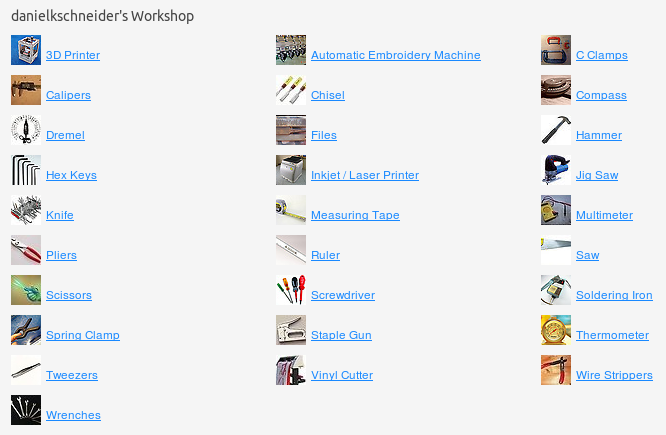
Social networking services like Facebook do provide badges that you can use on other websites, e.g. the "I like" button. Linkedin allows users in their profile to define a list of skills and expertises. Below is a rather randomly created list for the main author of this entry:
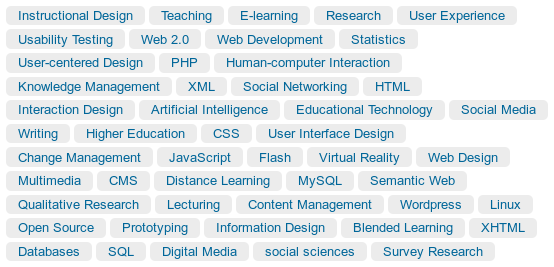
These examples show inventories that some may not qualify as lists of batches since they were created and authorized by the user. However, they do offer the same kind of functionality, i.e. visually tag a person with links that point directly or indirectly to skills.
McCrea's Pedagogy badges
Peps Mccrea (University of Brighton) and Jeremy Burton, in the 2012 JISC JISC elevator contest, proposed pedagogy badges. Their purpose are:
- Become more aware of their current e-learning and blended practice
- Become more aware of their desired practice, and how this differs from the above
- Become more aware of the pedagogical affordances of technology for teaching and learning
- Have better discussions about how we teach
- Change the way we teach
(retrieved March 14, 2012)
The initial proposal (to be refined) was made through a video of which we should a screen capture below. To the right is the initial sketch of a palette allowing to describe a pedagogy and to the left, an example activity tagged with some of these badges.
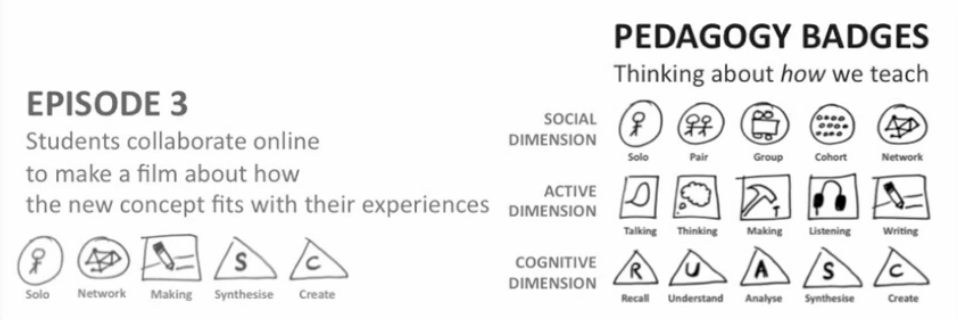
Comment
I like the idea of creating a simple palette of icons for describing pedagogical scenarios, i.e. some compromise between over-simplistic big categories and complex learning taxonomies à la DialogPlus. Of course, this idea must be tested first (1) with respect to its expressiveness, (2) whether normal teachers can use it and (3) and whether others could read the icons. After usability is ok, it's in the open whether it could be adopted or not. - Daniel K. Schneider 15:10, 14 March 2012 (CET)
Technical aspects of Mozilla OpenBadges
Mozilla OpenBadges set the standard (by 2013/2014).
Open Badges are:
- Free and open: Mozilla Open Badges is not proprietary. It’s free software and an open technical standard any organization can use to create, issue and verify digital badges.
- Transferable: Collect badges from multiple sources, online and off, into a single backpack. Then display your skills and achievements on social networking profiles, job sites, websites and more.
- Stackable: Whether they’re issued by one organization or many, badges can build upon each other and be stacked to tell the full story of your skills and achievements.
- Evidence-based: Open Badges are information-rich. Each badge has important metadata which is hard-coded into the badge image file itself that links back to the issuer, criteria and verifying evidence.
Open Badges make it easy to:
- Get recognition for the things you learn;
- Give recognition for the things you teach;
- Verify skills; and
- Display your verified badges across the web.
(MozillaWiki, retrieved April 23, 2014)
The Mozilla OpenBadges project proposes the following architecture: “Any Badge Issuer (for example, an after-school program, free online course, or vocational institute) can award Badges to learners like you. Learners/users can then collect and manage their badges in a Badge Backpack. This makes it easy to display your skills and achievements across a range of different Display Sites -- from your personal resume or web site, to social networking profiles, to employment sites.”, retrieved 18:52, 14 March 2012 (CET).
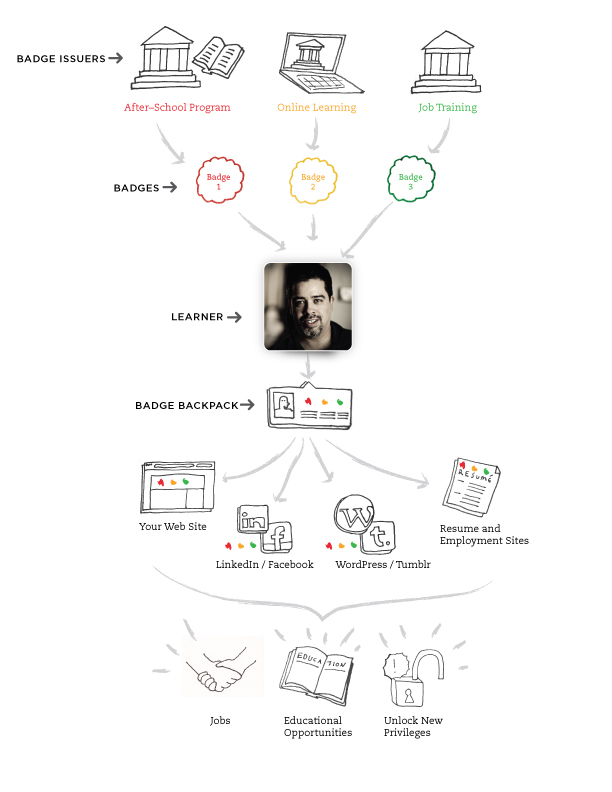
An OpenBadge includes (roughly) the following information. For details, see the Assertion specification:
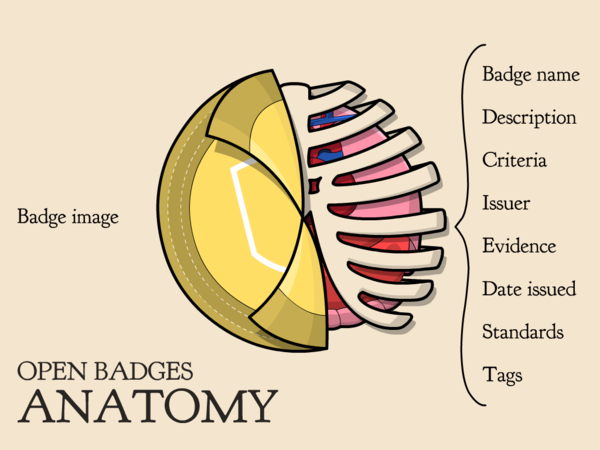
OpenBadges Specification
The Specification as of April 2014, includes several parts:
- The Assertion defines the main specification for the badge data, i.e. how badges are made and verified. There exist two variants: signed and hosted badges, but their content is the same and includes six categories of about 30 fields.
- The Baking is the process of embedding a badge assertion into an image (a PNG or an SVG) so that where ever that image goes, the assertion data goes with it and the badge can be independently verified.
- The Backpack defines a web site/application that can take in & export badges. As of April 2014, this specification does not yet exist.
Software for Endusers
- Some LMS, e.g. Moodle (> 2.5) provide openBadges support
- Mozilla Backpack provides a virtual place where you can store badges.
Software for developers
Mozilla provides several foundational tools to make the badging process easy. The source code and the technical specifications are available from several places, for example.
Search Mozilla's Github for "badge" or, better, start from the documentation in the Mozilla Wiki.
Designing badges
Graphics
- Read OpenBadges Community's Design tips.
Visuals
Visually, Badges first appear as icons. These icons are also buttons, i.e. display further information when the user clicks on them. Depending on the context of use, there are some visual rules with respect to size.
It seems that there are no standards for the visual design. However, at some point we might see some informal consensus. For now, we believe that a bade should include:
- Text that summarizes the skill, experience, achievement
- The name (or maybe logo) of the issuer
- Some graphic that makes a badge part of a series
Typical web badge sizes, according to Wikipedia are: 36x13, 80x15, 88x31, 110x32, 120x60, 125x50, 180x60. E.g. the badges used by a Mediawiki to display technology and licenses are 88x31 pixels (see the bottom of this page). The same Wikipedia page also indexed some badge generation tools. See also its Icon and Widget toolkit articles.
However, web badges are not educational badges. We could expect educational badges to adhere to a more common squared format.
- For example, badges.mozilla.org displays badges as 128x128px (scaled in overview pages) or as 256x256px), e.g. Badge: Information Literacy Certificate and same in a category page
- The Mozilla backpack seems to scale badges to 128px or to 64 (depending on the view)
Creating badges in Moodle
Moodle badges (starting with version 2.5) can be exported to the Mozilla Backpack.
Read Moodle for some more information.
Links
General
- Pedagogy Badges: disrupting how we teach March 5, 2012 by peps mccrea
Badge Design
- Badge Design Canvas at Digitalme.co.uk
- https://openbadges.me/
Technical frameworks
- Openbadges.org, Mozilla foundation. As of August 2019, their own backpacking service will be discontinued. Users will have to migrate to Badgr.
- MozillaWiki (includes documentation)
Backpacks (place to store badges)
- https://badgr.com/
- Open Badges Backpack 2.0 (explanations, including migration from Mozilla)
- Mozilla backpack (discontinued, Aug 2019)
As achievement indicator
- Or Equivalent (2011) by David Wiley.
- Response to David Wiley on an education “badge” system by Larry Sanger, September 20, 2011.
- Open Badges for Lifelong Learning (Mozilla white paper) by The Mozilla Foundation and Peer 2 Peer University, in collaboration with The MacArthur Foundation
For qualifying artifacts
- Pedagogy badges by Peps Mccrea (2012)
Examples in education
- https://badgr.com/ (continuing the Mozilla backpack)
- Digital badges show students' skills along with degree, Purdue University News, Sept 2011.
- Badges For Lifelong Learning Competition (A 2011/2012 competition with 30 entrants)
- Badges For Lifelong Learning Competition Stage One Learning Content Winners And Collaborators (As of March 2012, probably the best page to start browsing).
- See also: Badges For Lifelong Learning Competition Winners Announced. PDF (March 1, 2012)
- Mozilla Open Badges program (discontinued as of Aug 2019).
Other examples
- Stackoverflow (E.g. search for badges
Bibliography
- Ahn, J., Pellicone, A., & Butler, B. S. (2014). Open badges for education: What are the implications at the intersection of open systems and badging? Research in Learning Technology. 22(1), 1–13.
- Antin, J., & Churchill, E. F. (2011). Badges in social media: A social psychological perspective. Proceedings of CHI 2011 Gamification Workshop. Canada. ACM 978-1-4503-0268-5/11/05.
- Archambault, J. et Chouinard, R. (1996). Vers une gestion éducative de la classe. Québec : Gaëtan Morin.
- Besser, E. D. (2016). Exploring the role of feedback and its impact within a Digital Badge system from multiple perspectives: A case study of preservice teachers (Doctoral dissertation). Retrieved from ProQuest Dissertations and Theses. (ProQuest No. 10151547).
- Bowen, K., & Thomas, A. (2014). Badges: A common currency for learning. Change: The Magazine of Higher Learning, 46(1), 21–25. https://doi.org/10.1080/00091383.2014.867206
- Cameron, J. (2001). Negative effects of rewards on intrinsic motivation – a limited phenomenon: comment on Deci, Koestner, and Ryan (2001). Review of Educational Research, 71, 29-42.
- Cheng, Z., Watson, S. L., & Newby, T. J. (2018). Goal Setting and Open Digital Badges in Higher Education. TechTrends, 62(2), 190–196. https://doi.org/10.1007/s11528-018-0249-x
- Chou, C. C., & He, S. J. (2017). The Effectiveness of Digital Badges on Student Online Contributions. Journal of Educational Computing Research, 54(8), 1092–1116. https://doi.org/10.1177/0735633116649374
- Cucchiara, S., Giglio, A., Persico, D., & Raffaghelli, J. E. (2014). Supporting self-regulated learning through digital badges: A case study. New Horizons in Web Based Learning, 133–142. https://doi.org/10.1007/978-3-319-13296-9_15
- Devedžić, V., & Jovanović, J. (2015). Developing Open Badges: A comprehensive approach. Educational Technology Research and Development, 63, 603–620. https://doi.org/10.1007/s11423-015-9388-3
- Dyjur, P., & Lindstrom, G. (2017). Perceptions and Uses of Digital Badges for Professional Learning Development in Higher Education. TechTrends, 61(4), 386–392. https://doi.org/10.1007/s11528-017-0168-2
- Deci, E.L., Koestner, R. et Ryan, R.M. (2001). Extrinsic rewards and intrinsic motivation in education: reconsidered once again. Review of Educational Research, 71, 1-27.
- Elkordy, A. (2016). Development and Implementation of Digital Badges for Learning Science, Technologly, Engineering and Math (STEM) Practices in Secondary Contexts: A Pedagogical Approach with Empirical Evidence. In D. Ifenthaler, N. Bellin-Mularski, & D. Mah (Eds.), Foundations of digital badges and micro-credentials (pp. 483–508). Springer International.
- Fields, E. (2015). Making visible new learning: professional development with open digital badge pathways. Partnership: The Canadian Journal of Library and Information Practice and Research, 10(1), 1–10.
- Fanfarelli, J., Vie, S., & McDaniel, R. (2015). Understanding digital badges through feedback, reward, and narrative: a multidisciplinary approach to building better badges in social environments. Communication Design Quarterly Review, 3(3), 56–60.
- Finkelstein, J., Knight, E., & Manning, S. (2013). The potential and value of using badges for adult learners. American Institute for Research. https://lincs.ed.gov/publications/pdf/AIR_Digital_Badge_Report_508.pdf
- Frederiksen, L. (2013). Digital Badges. Public Services Quarterly, 9(4), 321–325. https://doi.org/10.1080/15228959.2013.842414
- Gamrat, C., Zimmerman, H. T., Dudek, J., & Peck, K. (2014). Personalized workplace learning: An exploratory study on digital badging within a teacher professional development program. British Journal of Educational Technology, 45(6), 1136–1148.
- Gibson, D., Ostashewski, N., Flintoff, K., Grant, S., & Knight, E. (2013). Digital badges in education. Education and Information Technologies, 20(2), 403–410.
- Glover, I. (2013). Open badges: A visual method of recognising achievement and increasing learner motivation. Student Engagement and Experience Journal, 2(1). doi: 10.7190/seej.vlil.66
- Kwon, K. H., Halavais, A., & Havener, S. (2015). Tweeting Badges: User Motivations for Displaying Achievement in Publicly Networked Environments. Cyberpsychology, Behavior and Social Networking, 18(2), 93–100.
- Lepper, M.R. et Hodell, M. (1989). Intrinsic Motivation in the Classroom. Dans R.E. Ames, et C. Ames (dir.), Research on motivation in education, Goals ans cognition, vol. 3 (p. 73-106). Toronto: Academic Press.
- McDaniel, R., & Fanfarelli, J. (2016). Building better digital badges: Pairing completion logic with psychological factors. Simulation & Gaming, 47(1), 73–102.
- Randall, D. L., Harrison, J. B., & West, R. E. (2013). Giving credit where credit is due: Designing open badges for a technology integration course. TechTrends, 57(6), 88–95. https://doi.org/10.1007/s11528-013-0706-5
- Rughinis, R. (2013). Talkative objects in need of interpretation. Re-thinking digital badges in education. CHI '13 Extended Abstracts on Human Factors in Computing Systems (pp. 2099–2108). https://doi.org/10.1145/2468356.2468729.
- Stetson-Tiligadas, S. M. (2016). The impact of digital achievement badges on undergraduate learner motivation (Doctoral dissertation, Capella University).
- Viau, R. (2009). La motivation en contexte scolaire. Bruxelles : De Boeck.